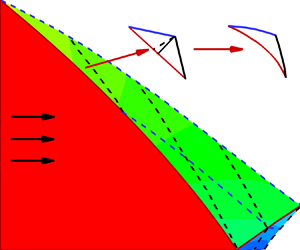Article contents
Method of curved-shock characteristics with application to inverse design of supersonic flowfields
Published online by Cambridge University Press: 14 June 2021
Abstract

This paper describes the development of a method of curved-shock characteristics based on curved shock theory. The proposed method is applied to supersonic flowfield calculations and inverse design in planar/axisymmetric, external/internal and uniform/non-uniform flows. The main idea is to determine the gradients of the pressure and flow deflection angle in the streamline-characteristic coordinates. With the acquired derivatives, the flow parameters of the post-shock flowfield can be quickly identified. Compared with the method of characteristics, the gradient information enhances the computational efficiency and accuracy of the method of curved-shock characteristics. This makes the method of curved-shock characteristics more effective, accurate and robust than the conventional method of characteristics. Explicit equations in the form of gradients are derived along the streamlines and characteristics. Several supersonic flowfields are solved using the method of curved-shock characteristics, and the results show that the proposed method requires less computational resources, by an order of magnitude, than the method of characteristics while achieving superior accuracy. Additionally, the proposed method is applied to the inverse design of internal flows. A series of planar and axisymmetric flowfields with centre-bodies are solved under the condition that the shock curves are given. The accuracy and efficiency of the method of curved-shock characteristics make it a good candidate for the inverse design of planar/axisymmetric supersonic flowfields.
- Type
- JFM Papers
- Information
- Copyright
- © The Author(s), 2021. Published by Cambridge University Press
References
REFERENCES
- 12
- Cited by





